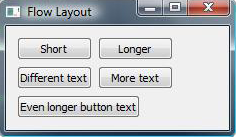FlowLayout Class Implementation
We start off by looking at the constructor:
FlowLayout::FlowLayout(QWidget *parent, int margin, int hSpacing, int vSpacing)
: QLayout(parent), m_hSpace(hSpacing), m_vSpace(vSpacing)
{
setContentsMargins(margin, margin, margin, margin);
}
FlowLayout::FlowLayout(int margin, int hSpacing, int vSpacing)
: m_hSpace(hSpacing), m_vSpace(vSpacing)
{
setContentsMargins(margin, margin, margin, margin);
}
In the constructor we call setContentsMargins() to set the left, top, right and bottom margin. By default, QLayout uses values provided by the current style (see QStyle::PixelMetric).
FlowLayout::~FlowLayout()
{
QLayoutItem *item;
while ((item = takeAt(0)))
delete item;
}
In this example we reimplement addItem(), which is a pure virtual function. When using addItem() the ownership of the layout items is transferred to the layout, and it is therefore the layout's responsibility to delete them.
void FlowLayout::addItem(QLayoutItem *item)
{
itemList.append(item);
}
addItem() is implemented to add items to the layout.
int FlowLayout::horizontalSpacing() const
{
if (m_hSpace >= 0) {
return m_hSpace;
} else {
return smartSpacing(QStyle::PM_LayoutHorizontalSpacing);
}
}
int FlowLayout::verticalSpacing() const
{
if (m_vSpace >= 0) {
return m_vSpace;
} else {
return smartSpacing(QStyle::PM_LayoutVerticalSpacing);
}
}
We implement horizontalSpacing() and verticalSpacing() to get hold of the spacing between the widgets inside the layout. If the value is less than or equal to 0, this value will be used. If not, smartSpacing() will be called to calculate the spacing.
int FlowLayout::count() const
{
return itemList.size();
}
QLayoutItem *FlowLayout::itemAt(int index) const
{
return itemList.value(index);
}
QLayoutItem *FlowLayout::takeAt(int index)
{
if (index >= 0 && index < itemList.size())
return itemList.takeAt(index);
else
return 0;
}
We then implement count() to return the number of items in the layout. To navigate the list of items we use itemAt() and takeAt() to remove and return items from the list. If an item is removed, the remaining items will be renumbered. All three functions are pure virtual functions from QLayout.
Qt::Orientations FlowLayout::expandingDirections() const
{
return 0;
}
expandingDirections() returns the Qt::Orientations in which the layout can make use of more space than its sizeHint().
bool FlowLayout::hasHeightForWidth() const
{
return true;
}
int FlowLayout::heightForWidth(int width) const
{
int height = doLayout(QRect(0, 0, width, 0), true);
return height;
}
To adjust to widgets of which height is dependent on width, we implement heightForWidth(). The function hasHeightForWidth() is used to test for this dependency, and heightForWidth() passes the width on to doLayout() which in turn uses the width as an argument for the layout rect, i.e., the bounds in which the items are laid out. This rect does not include the layout margin().
void FlowLayout::setGeometry(const QRect &rect)
{
QLayout::setGeometry(rect);
doLayout(rect, false);
}
QSize FlowLayout::sizeHint() const
{
return minimumSize();
}
QSize FlowLayout::minimumSize() const
{
QSize size;
QLayoutItem *item;
foreach (item, itemList)
size = size.expandedTo(item->minimumSize());
size += QSize(2*margin(), 2*margin());
return size;
}
setGeometry() is normally used to do the actual layout, i.e., calculate the geometry of the layout's items. In this example, it calls doLayout() and passes the layout rect.
sizeHint() returns the preferred size of the layout and minimumSize() returns the minimum size of the layout.
int FlowLayout::doLayout(const QRect &rect, bool testOnly) const
{
int left, top, right, bottom;
getContentsMargins(&left, &top, &right, &bottom);
QRect effectiveRect = rect.adjusted(+left, +top, -right, -bottom);
int x = effectiveRect.x();
int y = effectiveRect.y();
int lineHeight = 0;
doLayout() handles the layout if horizontalSpacing() or verticalSpacing() don't return the default value. It uses getContentsMargins() to calculate the area available to the layout items.
QLayoutItem *item;
foreach (item, itemList) {
QWidget *wid = item->widget();
int spaceX = horizontalSpacing();
if (spaceX == -1)
spaceX = wid->style()->layoutSpacing(
QSizePolicy::PushButton, QSizePolicy::PushButton, Qt::Horizontal);
int spaceY = verticalSpacing();
if (spaceY == -1)
spaceY = wid->style()->layoutSpacing(
QSizePolicy::PushButton, QSizePolicy::PushButton, Qt::Vertical);
It then sets the proper amount of spacing for each widget in the layout, based on the current style.
int nextX = x + item->sizeHint().width() + spaceX;
if (nextX - spaceX > effectiveRect.right() && lineHeight > 0) {
x = effectiveRect.x();
y = y + lineHeight + spaceY;
nextX = x + item->sizeHint().width() + spaceX;
lineHeight = 0;
}
if (!testOnly)
item->setGeometry(QRect(QPoint(x, y), item->sizeHint()));
x = nextX;
lineHeight = qMax(lineHeight, item->sizeHint().height());
}
return y + lineHeight - rect.y() + bottom;
}
The position of each item in the layout is then calculated by adding the items width and the line height to the initial x and y coordinates. This in turn lets us find out whether the next item will fit on the current line or if it must be moved down to the next. We also find the height of the current line based on the widgets height.
int FlowLayout::smartSpacing(QStyle::PixelMetric pm) const
{
QObject *parent = this->parent();
if (!parent) {
return -1;
} else if (parent->isWidgetType()) {
QWidget *pw = static_cast<QWidget *>(parent);
return pw->style()->pixelMetric(pm, 0, pw);
} else {
return static_cast<QLayout *>(parent)->spacing();
}
}
smartSpacing() is designed to get the default spacing for either the top-level layouts or the sublayouts. The default spacing for top-level layouts, when the parent is a QWidget, will be determined by querying the style. The default spacing for sublayouts, when the parent is a QLayout, will be determined by querying the spacing of the parent layout.























